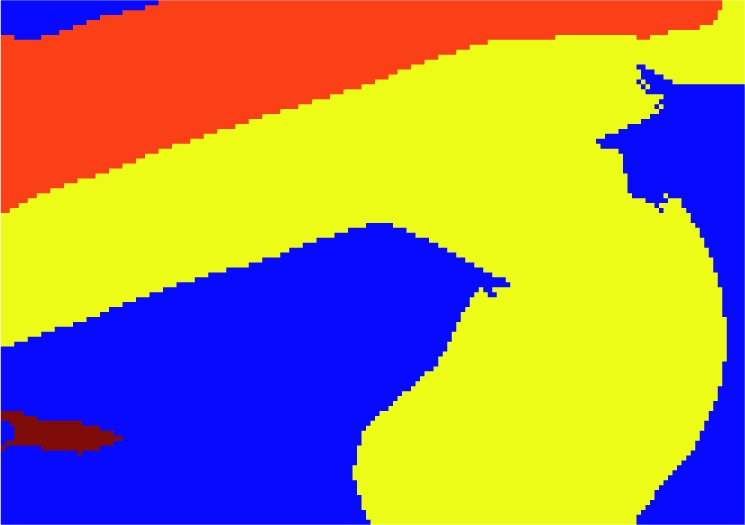| Projects | |
|
|
Floor Fields for Tracking in High Density Crowd Scenes
Tracking individuals in a high density crowd scene is challenging for a number of reasons: 1) the number of pixels on an object decreases with the increasing density of the objects; 2) constant interaction among the individuals in a crowd makes it hard to discern individuals from one another; 3) occlusions caused by inter-object interactions result in the loss of observation of the target object; 4) the mechanics of a human crowd is complex as it exhibits goal-directed dynamics and psychological characteristics which in turn influence how an individual person will behave in a crowd. ..... Click Here |

|
Action Recognition Using Multiple Features
The fusion of multiple features is important for recognizing actions, since a single feature based representation is not enough to capture imaging variations (view-point, illumination etc.) and attributes of individuals (size, age, gender etc.). We propose to use two types of features: The first feature is the quantized vocabulary of local spatio-temporal (ST) volumes (or cuboids) that are centered around 3D interest points in the video. The second feature is a quantized vocabulary of spin-images, which is aimed at capturing the 3D shape of the actor by considering actions as 3D objects. To optimally combine these features, we develop a mathematical framework that treats different features as nodes in a graph, where weighted edges between the nodes represent the strength of the relationship between entities. The graph is then embedded..... Click Here |




|
Crowd Flow Segmentation & Stability Analysis
Video surveillance in public places is proliferating at an unprecedent rate, from closed-circuit security systems that can monitor individuals at airports, subways, concerts, sporting events etc., to network of cameras blanketing important locations within a city. Over the years, a number of intelligent surveillance systems have been developed for effective and efficient processing of the video footage generated by these surveillance cameras. However, despite the sophistication of these systems, they have not yet attained the desirable level of applicability and robustness required for the real-world settings and uncontrolled conditions. This is largely due to the algorithmic assumptions about the density of objects in a scene that are often violated in the real world environment..... Click Here |

|
Chaotic Invariants for Human Action Recognition
This project explores the feasibility of theory of chaotic systems for solving different vision problems. As a first step, we have used it to model and analyze nonlinear dynamics of human actions, where trajectories of body joints are used as the representation of the non-linear dynamical system generating the action. Using these trajectories, each action is represented in terms of Chaotic Invariants which measure the dynamical and metric structure of the reconstructed phase spaces corresponding to each trajectory..... Click Here |

|
Target Reacquisition in Aerial Videos
In this project, we attempt to solve the problem of persistent tracking in aerial imagery by using novel ideas of Motion and Appearance Contexts. Motion context is a collection of trajectories belonging to objects in the given environment, which are representative of the motion of the occluded or unobserved object. Appearance context of an occluded object consists of appearance information of all other occluded or unobservable objects in the environment. This appearance context is incorporated by learning a distribution of interclass variation for each target-unobservable object pair ...... [Under Construction] |

|
COCOA: Alignment, Object Detection, Object Tracking and Indexing of Aerial Videos
COCOA, is a modular system capable of performing motion compensation, moving object detection, object tracking and indexing of videos taken from a camera mounted on a moving aerial platform (e.g. UAVs). In order to index a video COCOA processes it through a number of stages. At first stage, motion of the aerial platform is compensated by employing one of the several frame to frame alignment methods which are available in COCOA. Second stage performs moving object detection by employing a hybrid approach which involves frame differencing, background modeling and object segmentation. In third stage, foreground regions are tracked as long as they remain within..... Click Here |

|
Missile Route Planning using Image based GPS Localization
In this project we explored the possibility of using image based GPS localization for missile and UAV route planning. We developed a simulation software for this purpose. Given a set of images taken at the smae geographical location with known GPS locations, the problem was to find the current GPS location of the missile on the fly and steer it towards the target location. of test images taken at unknown locations but roughly in the same area (view overlap). During missile flight, the live new images are compared with the images in the database ...... Click Here |

|
Cotraining for Moving Object Detection and Classification
Major limitations of classification algorithms like Adaboost, SVMs, or Na´ve Bayes include, i) requirement of a large amount of labeled training data. and ii) parameters of the classifier are fixed after the end of training phase, i.e., these classifiers can not attune themselves to particular detection scenarios after their deployment. To overcome above mentioned shortcomings, the algorithm proposed in this project has following properties: i) Requirement of minimal training data, ii) automated online selection of training examples after deployment for continuous improvement, and iii) near real time performance (4-5 frames/sec). ..... Click Here |
|
|
Object Detection Framework
In recent years Kernel Principal Component Analysis (Kernel PCA) has gained much attention because of its ability to capture nonlinear image features, which are particularly important for encoding image structure. Boosting has been established as a powerful learning algorithm that can be used for feature selection. In this paper we present a novel framework for object class detection that combines the feature reduction and feature selection ..... Click Here |


